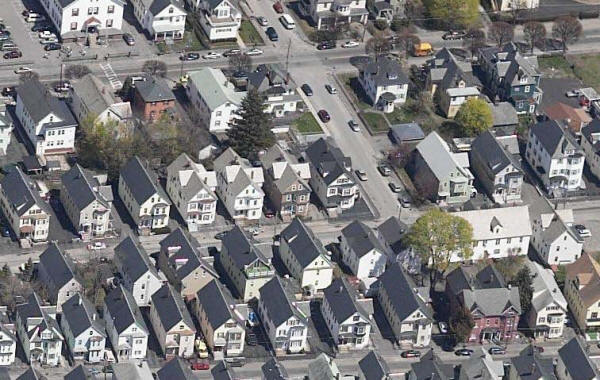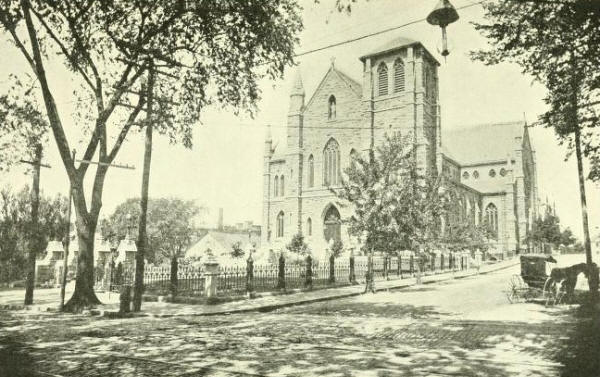 |
 |
||||||
|
History: Concord River Neighborhoods Founding of Belvidere Village Historically the Concord River area of Lowell has been home to several neighborhoods with quite distinct identities. The oldest, Belvidere Village, was part of Tewksbury until 1834 when it was annexed by the town of Lowell. The village had been established by Judge Edward S. L. Livermore, a prominent Federalist congressman formerly from Newburyport, when he purchased a large tract of farmland above the Merrimack and Concord rivers known as the “Gedney Estate” (the area currently the site of St. Joseph’s Hospital). [1]
Nestled along the east side of the Concord, Belvidere boasted a population of about 1,000 residents by the mid 1830s. [2] Its inhabitants ranged from the elite, including Judge Livermore’s family and newspaper editor Leonard Huntress, to artisans and small merchants and common laborers. The village gained a rough reputation due in part to the carousing and excessive rum-drinking in various taverns and cottages along the river. [3]
Class and Ethnicity
Most of the housing stock in Belvidere was built between the 1880s and 1920s and included wood-frame, single-family and multiple-family houses as well as tenements. The vast majority of these dwellings, for workers and their families, were erected on the streets closest to the Concord River. More affluent families, including a mix of Irish-American Catholics and native-born Protestants, resided in the area around Fort Hill Park. Into the 1920s, however, the neighborhood also retained a large middle-class population, especially along the blocks of Pleasant and High streets. [4]
The Neighborhood and Its Churches By the early 1900s a number of Catholic parishes were located in the Lower Belvidere area. This included the imposing Gothic-style Immaculate Conception Church (completed in 1877 and attended by parishioners mostly of Irish ancestry), Holy Trinity Church (completed in 1904), and St. Joseph’s Lithuanian Church (originally the Independent Polish Catholic Church and renovated by St. Joseph’s parish in 1911). Politics and Culture As in other neighborhoods, the churches in Lower Belvidere generally exerted a socially and politically conservative influence over its members. Nonetheless, a small group of socialists and then communists emerged in Lowell by the 1910s and this left-wing element was especially vibrant within the Polish and Lithuanian communities in Lower Belvidere. One leader, Joseph J. Nadworny, a Russian Polish émigré, lived on High Street with his Polish-born wife Amelia, five-year-old son John, and a 12-year old lodger, Olga Mazik. Nadworny had immigrated to the United States in 1908 and was living in Lowell by 1919, directly across from the Polish Catholic Church. Initially employed at the U.S. Cartridge Company, Nadworny obtained a job as an edge trimmer at a shoe factory in Lawrence. In Lowell, Nadworny served as secretary of the Polish Communists, which met regularly at Socialist Hall on Middle Street. In late 1919, as part of the notorious Palmer raids on suspected leftists and radicals, U.S agents and Lowell police raided Socialist Hall, arresting several men and obtaining the names of additional “reds,” including that of Nadworny. Lowell police then visited Nadworny’s High Street residence, expecting to uncover radical literature. Instead they found “a generous display of American flags, and red, white, and blue displayed on all sides.” Believing they were mistaken, authorities left Nadworny undisturbed. Police superintendent Welch, however, was convinced that Nadworny was a “red." When Welch received word that a “radical,” who had been arrested in Cambridge, Massachusetts, was carrying a Nadworny-signed letter concerning financial support for leftist activities, he ordered police to pick him up. Nadworny was then sent to the prison at Deer Island in Boston Harbor, where he was confined with hundreds of other suspects from the Boston region. [5] Nadworny and a number of other Lowell residents imprisoned on Deer Island were subsequently released. It is not known if Nadworny remained active in left-wing politics but by 1930 he was living in Chelmsford in a house that he owned and was working as a shoemaker at the Phyliss Shoe Company factory on Bridge Street. [6] Industrial Decline and Neighborhood Struggles For many Lowell textile workers the 1920s marked the beginning of nearly two decades of economic struggle, with numerous mills in the city shutting down or curtailing production. Despite a severe nationwide recession in 1921, which hit hard the textile industry and prompted wage cuts of 20 percent throughout New England, Lowell’s population continued to grow during the mid 1920s. Lower Belvidere neighborhood experienced a slight increase in its Polish, Lithuanian, and Armenian population and, overall, the city recorded an increase of nearly 2,000 dwellings between 1920 and 1924. [7] By 1930, however, population gains in Lowell dramatically reversed and the Johnson immigration bill of 1924 resulted in many fewer émigrés settling in the United States. Property values in Lower Belvidere as in other neighborhoods dropped precipitously during the 1930s and the quality of the housing stock declined as well. Hear Mary Lou Looney talk about growing up in a cold-water tenement in Lower Belvidere in the 1950s:
Recent Developments Similar to other working-class neighborhoods in Lowell, Lower Belvidere has experienced considerable change in the past 25 years. During the post-World War II years many in the inner city who could afford to move, relocated to out-lying areas or to suburban developments outside of Lowell. As a result, neighborhoods became even more segregated, with income, rather than ethnicity, being the determining factor. In the late 1970s and 1980s, however, refugees from Southeast Asia and immigrants from the Spanish-speaking nations of the Caribbean settled in Lowell. Many of these newcomers were drawn to the relatively inexpensive rental properties in such neighborhoods as Belvidere, Back Central, and Swede Village. As in earlier periods in Lowell’s history, the influx of people from different ethnic and cultural backgrounds sparked social tensions, yet offered the promise of a citizenry enriched by new perspectives, skills, and shared aspirations for a better life. Hear long-time Swede Village resident John Quealy discuss changes in his neighborhood.
FOOTNOTES [2] Benjamin Floyd, “The Lowell Directory: Containing Names of the Inhabitants and Their Occupations, Places of Business, and Dwelling Houses … to which is Annexed a Directory of Belvidere Village", (Lowell, MA: 1834), p. 9. [3] George Hedrick, “Reminiscences and Recollections of Lowell since 1831,” pp. 357-361. [4] See the 1920 Federal Census for Lowell, Ward 5, along with the Lowell City Atlas, 1924. [5] For information on Nadworny see Federal Census, 1920, Lowell, Massachusetts, Microfilm Roll 711A, Enumeration District 214, p. 82A, and city directories, 1919 and 1920. For accounts of his arrest see “Two More Radical Suspects Arrested,” Lowell Courier-Citizen, January 14, 1920, and the Lowell Sun, January 13, 1920. The other man arrested, Paul Kazura, allegedly admitted to being a member of the Russian Communists of Lowell. Kazura lived on Hale Street in a predominately Russian Jewish neighborhood and police found “a large amount of radical literature,” including “a group picture of Trotzky [sic], Lenine [sic], and Eugene V. Debs” hanging on a wall. For descriptions of the “subversive” material police found at his home see the same newspaper article cited above. [6] Federal Census, Chelmsford, Massachusetts, 1930; draft registration card for Joseph J. Nadworny, 1942. According to this draft card Nadworny was born in Konin, Poland, on March 19, 1888. By 1942 he was still living in Chelmsford with his wife Amelia and was working at the Phyliss Shoe Company. [7] This data is based on a survey carried out by Lowell’s Chamber of Commerce in 1924. See “Survey Shows City Is Growing Fast,” Lowell Courier-Citizen, December 24, 1924.
|




